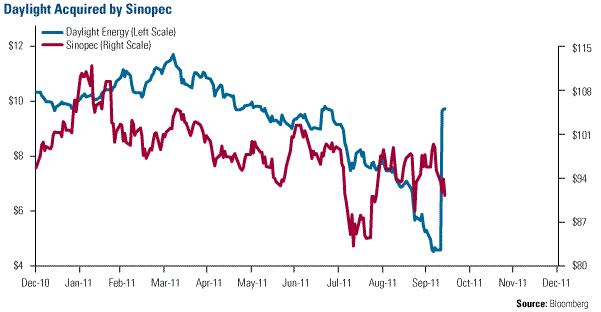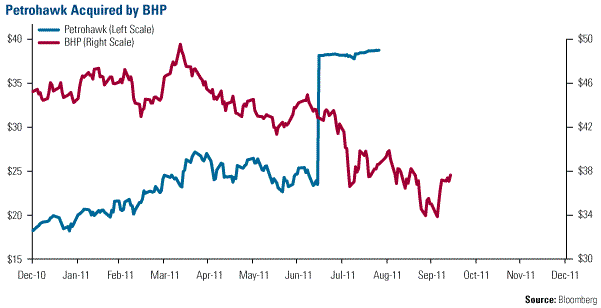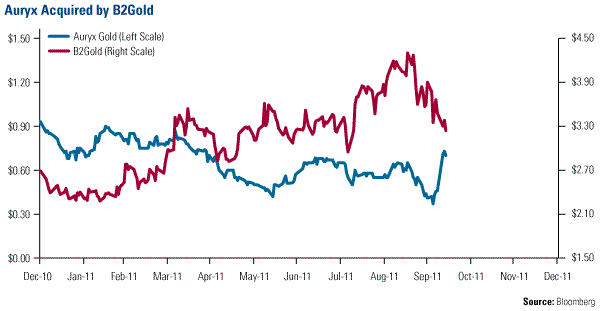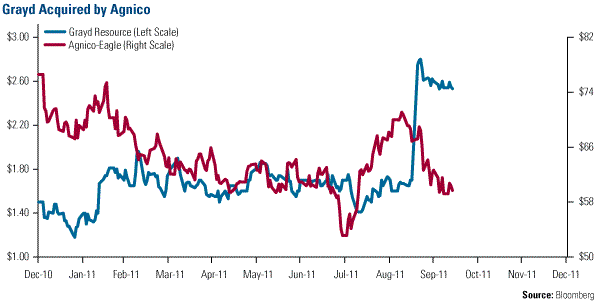Which Gold Miners Have Largest Upside? Buyouts Crystallize Value in the Market
Commodities / Gold and Silver 2011 Oct 17, 2011 - 02:33 PM GMTBy: Frank_Holmes
 There’s value in the market. That’s the message the market is sending through the recent strategic acquisitions in the energy and gold mining spaces.
There’s value in the market. That’s the message the market is sending through the recent strategic acquisitions in the energy and gold mining spaces.
Last week it was announced that Sinopec, a large Chinese oil and gas company, is purchasing Canadian energy company Daylight Energy for $2.1 billion in cash. The deal was struck at a whopping 120 percent premium to Daylight’s share price prior to the announcement and a 43.6 percent premium over the 60-day weighted average price, according to Reuters.

Back in July, the first large-cap company to go discount shopping was BHP Billiton when it purchased Petrohawk Energy for just over $15 billion. The deal, which gives BHP access to the highly coveted shale gas reserves, was struck at $38.75 per share, a 49 percent premium from where Petrohawk shares were trading prior to the announcement.

Not to be outdone, the gold mining sector got into the action when B2Gold announced it was purchasing Auryx Gold in a $160 million cash, all-stock deal. The deal represented a 74 percent premium on Auryx Gold’s shares from the previous week’s close.

It was also announced that Agnico-Eagle had gained access to promising gold prospects in Mexico via Canada by agreeing to purchase Canadian gold miner Grayd Resource Corp in a $463.5 million deal. At $2.80 per share (Canadian), the buyout represents a nearly 66 percent premium over the trading price prior to Agnico’s announcement.

The strategy behind each deal is specific to the purchasing companies but all four deals crystallize the inherent value in the equity market. Junior exploration and development companies in both the energy and gold mining sectors have suffered steep declines during the market selloff that began in April.
Large-cap companies in both energy and gold mining must continually replace diminishing reserves. For example, decline rates for oil-producing wells in the Gulf of Mexico can range between 15-30 percent a year and significant investments must be made to keep the well producing, according to BP. Establishing new wells is also expensive. An offshore exploration well, for example, can cost $100-$200 million dollars and that doesn’t guarantee it will become a producing well.
In fact, currently the cheapest barrels of oil and ounces of gold aren’t in the ground, they’re listed on the stock exchange. This is why the smart money, such as the world’s largest mining company, is swooping in to pick up reserves at discounted prices. This could just be the tip-of-the-iceberg for BHP. BMO estimates the company will spend between $68-79 billion by 2020 to add unconventional shale assets to the company’s mammoth portfolio.
This isn’t a new phenomenon in the gold sector. As I explained in The Goldwatcher: Demystifying Gold Investing, the big miners have chosen the express route to increasing reserves by purchasing the known assets of their rivals rather than the heartache and headache of drilling core samples and filling out permit applications.
In addition, higher gold prices have filled the coffers of large-cap companies with plenty of cash. BMO forecasts that the gold mining universe will accumulate $120 billion in cash by 2015 if prices remain elevated.
We think this “takeout potential” creates one of the best opportunities in today’s market.
Editor’s Note: The timing of this piece appears extremely appropriate. This piece was originally published on Friday, October 14 but two additional big mergers have been announced on Monday morning. Kinder Morgan is gobbling up its competition in a $21 billion acquisition of El Paso Corp. At a 37 percent premium to the 20-day share price, the deal is the second-largest M&A of 2011 behind AT&T’s purchase of T-Mobile, according to Reuters.
Also, it was announced this morning that Brigham Exploration is being acquired by Norway’s Statoil ASA for $4.4 billion. The deal was struck at a 40 percent premium to current Brigham share prices.
These two acquisitions represent the sixth and seventh takeouts of the year in the energy space, underscoring how the market has tremendously discounted the value of smaller energy companies.
U.S. Global Investors, Inc. is an investment management firm specializing in gold, natural resources, emerging markets and global infrastructure opportunities around the world. The company, headquartered in San Antonio, Texas, manages 13 no-load mutual funds in the U.S. Global Investors fund family, as well as funds for international clients.
Want to receive commentary from Frank and analysis from the rest of the U.S. Global Investors team delivered to your inbox every Friday? Sign up to receive our weekly Investor Alert at www.usfunds.com.
By Frank Holmes
CEO and Chief Investment Officer
U.S. Global Investors
U.S. Global Investors, Inc. is an investment management firm specializing in gold, natural resources, emerging markets and global infrastructure opportunities around the world. The company, headquartered in San Antonio, Texas, manages 13 no-load mutual funds in the U.S. Global Investors fund family, as well as funds for international clients.
All opinions expressed and data provided are subject to change without notice. Some of these opinions may not be appropriate to every investor.
Standard deviation is a measure of the dispersion of a set of data from its mean. The more spread apart the data, the higher the deviation. Standard deviation is also known as historical volatility. All opinions expressed and data provided are subject to change without notice. Some of these opinions may not be appropriate to every investor. The S&P 500 Stock Index is a widely recognized capitalization-weighted index of 500 common stock prices in U.S. companies. The NYSE Arca Gold BUGS (Basket of Unhedged Gold Stocks) Index (HUI) is a modified equal dollar weighted index of companies involved in gold mining. The HUI Index was designed to provide significant exposure to near term movements in gold prices by including companies that do not hedge their gold production beyond 1.5 years. The MSCI Emerging Markets Index is a free float-adjusted market capitalization index that is designed to measure equity market performance in the global emerging markets. The U.S. Trade Weighted Dollar Index provides a general indication of the international value of the U.S. dollar.
Frank Holmes Archive |
© 2005-2022 http://www.MarketOracle.co.uk - The Market Oracle is a FREE Daily Financial Markets Analysis & Forecasting online publication.



